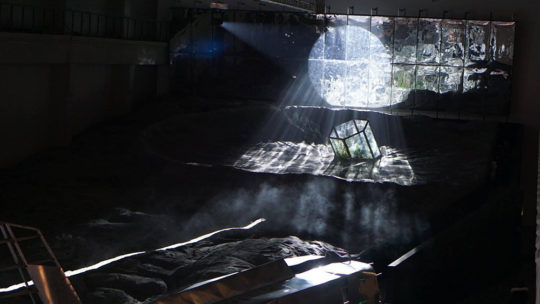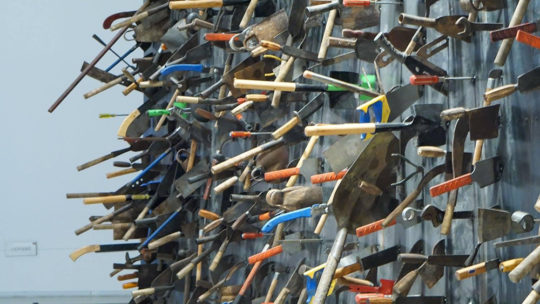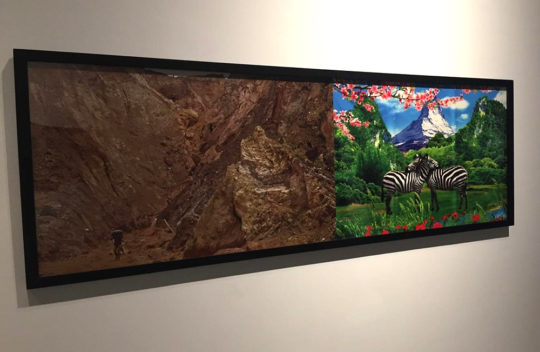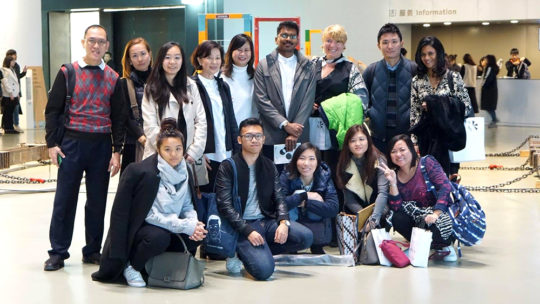by Usha Das
“Why not ask again?” This was the curatorial theme of the 11th Shanghai Biennale which the 2016 cohort of the MA Asian Art Histories Programme students were privileged to attend as part of our overseas study trip. This was indeed a fitting question as it brought to the fore issues which we had covered in the classroom during the very first semester of the MA Asian Art Histories Programme. Tony Bennett’s “The Exhibitionary Complex” will be a familiar article to those who have trodden the hallowed pathways of the Asian Art Histories Programme. It is one of the first pieces of required reading for the module on “Exhibitions and the Making of Art Histories in Asia.”
The basic idea—if slightly sinister—is a simple one. The concept of “panopticism” (i.e. an idea of permanent visibility created through a physical structure which allows for surveillance from a central point), is one which philosophically underpins modern museology. The most direct illustration of such idea lies within the carceral systems of eighteenth century Europe, whereby prison guards would centrally locate themselves in an observation tower so as to be able to view all prisoners at once. The element of spectacle fuses with power relations as exemplified through the all-mighty surveilling gaze.
Museums arguably apply similar concepts insofar as they “reverse the panoptical principle,” by “fixing the eyes of the multitude upon an assemblage of glamorous commodities.”1 In so doing, the power which accompanies knowledge (so derived from the ability to consume ideas about the various articles on display), is transferred to the viewer. Additionally, the viewers themselves become part the spectacle (for example, in being advised to adhere to dress codes, or when different classes of visitors are segregated in terms of access to events, or by ticket prices).
Conceptually, the art biennale occupies an intermediate space, somewhere between the worlds of the commercial gallery, public museum and national tourism initiatives. The works displayed are not for sale and yet inclusion in such prominent shows may well raise prices of works for the artists involved. The shows may be privately curated, but associations with sovereign geographic regions (i.e. Shanghai in China, Venice in Italy, etc.) clearly imbue such events with a nationalistic flavour, allowing countries to “shock and awe” with their own brand of artistic acrobatics.
The Shanghai Biennale has a particularly colourful history. Its third iteration in 2000 -2001 saw a satellite exhibition by Ai Wei Wei and independent curator Feng Boyi, entitled Fuck Off (or, as translated into more politically correct Chinese, “Uncooperative Attitude”). The works were deeply subversive and controversial; and the show was closed down a few days after its opening.
The 2016 Shanghai Biennale, while far less provocative, was no less engaging. We viewed a plethora of works but for the purposes of this article, a brief selection will be discussed, which perhaps best embody the principles referred to above.
In terms of “shock and awe” value, Mou Sen and MSG’s The Great Chain of Being—Planet Trilogy (Fig. 1), delivered in spades. It was a cavernous interactive installation which one entered through a gigantic “crashed” airplane structure, wedged in the middle of the exhibition space. Almost forty works were combined into a megastructure whose development was inspired by writers Samuel Beckett and William Shakespeare, as well as by the Red Flag Canal (an irrigation canal in Henan province, and propagandist symbol in Mao-era China). Whether by design or not, the work saw little by way of curatorial explanation, with viewers being left to simply experience the work’s overwhelming magnitude. Described as a “storytelling machine,”2 the piece was undoubtedly absorbing and all-consuming. It was impossible to photograph in its entirety and begged the question if it was even “art” in the first place, resembling more of a theme park amusement than something typically displayed in an art biennale or museum.

Fig. 1 Mou Sen and MSG, The Great Chain of Being—Planet Trilogy, 2016. Experimental theatre space, videos, sound, objects and bees. Photo credit: Eunice Lacaste
In contrast, Kolwezi (Fig. 2) by Sammy Baloji provided a darkly humorous look at China’s neo-colonial activities in Africa. Images of the barren slopes of copper and cobalt mines in Kolwezi (a city in the Democratic Republic of Congo), which have been developed and utilised by Chinese corporations, were laid alongside shiny, kitschy posters made in China. These posters decorate the makeshift bars, hotels, homes, hair salons and other social structures in “cities of tarpaulin”3 which have been erected to support mining activities in the region. One could “almost believe” that “(the) images of utopian futures (represented) the Congo of tomorrow.”4 The ravaged natural landscapes formed a fascinating counterpoint to the glossy false images in the posters. On one level this work could be read as a damning indictment of exploitative Chinese economic activities. Consider however, the situatedness of the work (i.e. in China, at a national exhibition such as the Shanghai Biennale), and deeper levels of meaning emerge. There is perhaps an arrogance to the display of the work for consumption at a commercial event within China, suggesting perhaps that resistance to China’s hegemony is futile, and that even biting social commentary is fair game for commodification within the juggernaut of Chinese geopolitical interests.
The Cell Art Group’s work As Long As You Work Hard (Fig. 3) saw artists assemble manual tools from farmers and workers in Longshui into a “cellular”5 form, suggesting growth and multiplication. Longshui’s cottage industry of tool making stands in “uneasy confrontation”6 with the industrial production of tools over the past two decades. The work presents a sly dig at stereotypical notions of Chinese mass-production, offering a profusion of manual tools stuck painfully into a wall. Viewers are perhaps reminded of the multiplicity of existing viewpoints, and of the fact that the Chinese are themselves not immune to the vagaries of consumerism and the advent of new technologies.

Fig. 3 Cell Art Group, As Long as You Work Hard, 2013. Tools, steel wall, video. Photo credit: Eunice Lacaste
In many ways, the Shanghai Biennale in its simple yet profound exhortation to pose questions and “reflect on things as they change with the passage of time” was a fitting end to our last class outing before the cohort broke up for our final semester of independent thesis research. Having been freed from the panoptical confines of school and released into the wider world, the question remains of what MAAH lessons we will continue to carry with us? Certainly, we could do worse than to follow the advice of Xiang Liping, Chief Coordinator of the Biennale, who suggests that one should pose questions, “regardless of whether there is an answer, or what the answer might be” as doing so elevates one’s consciousness towards new questioning, opening up loopholes in our thinking, and allowing for new perspectives to filter through.
————————————————————————
- Tony Bennett, “The Exhibitionary Complex,” in The Birth of the Museum: History, Theory, Politics, (London, New York: Routledge), 65. ↩
- Why Not Ask Again: 11th Shanghai Biennale, ed. Power Station of Art and Raqs Media Collective (China: China Academy of Art Press, 2016), 77. ↩
- Why Not Ask Again, 63. ↩
- Ibid. ↩
- Why Not Ask Again, 120. ↩
- Ibid. ↩



